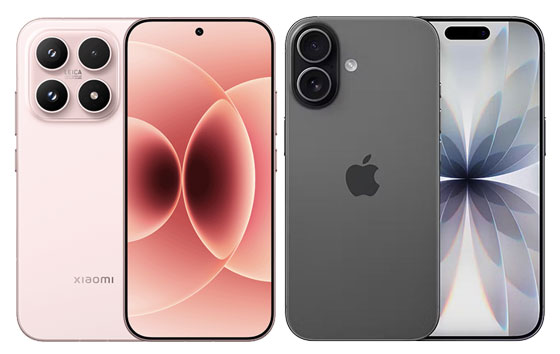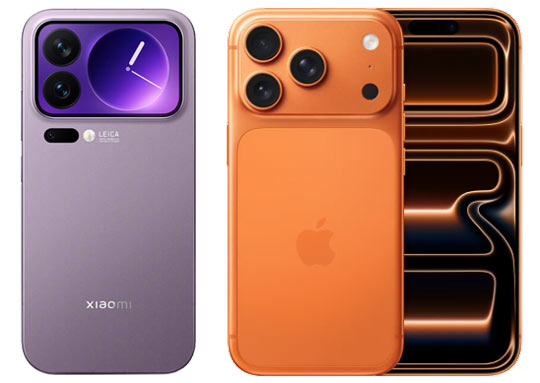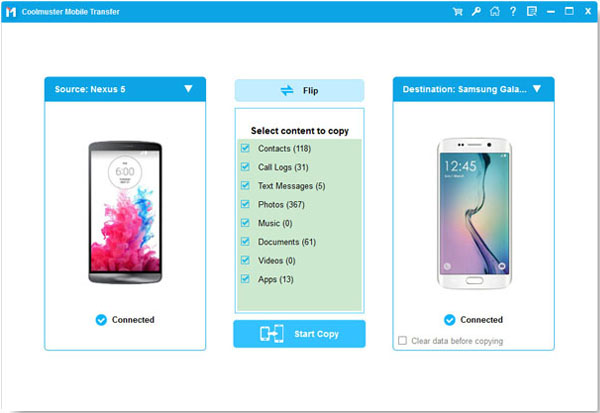As the Xiaomi 17 and iPhone 17 hit the market, tech enthusiasts are eager to know how these two giants compare. This article will explore the key differences between the Xiaomi 17 and the iPhone 17, analyzing both the base models and the Pro variants. If you want to learn more about Xiaomi 17 vs iPhone 17, read through this guide.

The primary differences between the Xiaomi 17 and iPhone 17 lines are rooted in their core design philosophies and their respective operating systems:
Operating System and Ecosystem: The iPhone 17 runs on iOS 26, offering the unmatched simplicity, security, and deep integration of the Apple ecosystem (Mac, iPad, Watch, AirPods). The Xiaomi 17 runs on Android 16 with HyperOS 3 layered on top, providing greater customization, sideloading freedom, and advanced features like multi-focus camera technology.
Battery and Charging: Xiaomi maintains a decisive lead in this area. The standard Xiaomi 17 features a massive 7000 mAh (China model) or 6330 mAh (Global model) battery with 100W wired and 50W wireless charging. In contrast, the iPhone 17 has a significantly smaller battery (3692 mAh) and sticks to much slower charging speeds, though it finally adopts a 120Hz display.
Chip Architecture: Both are built on an advanced 3nm process, but the iPhone 17's A19 chip (or A19 Pro in the Pro models) typically excels in single-core performance and long-term optimization. The Xiaomi 17's Snapdragon 8 Elite Gen 5 focuses on raw multi-core power, high clock speeds, and market-leading AI capabilities (on the Android side).
Pricing Strategy: The iPhone series continues to command a premium price and offers strong resale value. Xiaomi consistently undercuts Apple, providing high-end specifications at a significantly lower starting price, offering superior value for money.
Read also: You can also compare Google Pixel 10 series and iPhone 17 series in detail.
The standard models are often the volume sellers. If you want to know Xiaomi 17 vs iPhone 17 in specs, camera, price, chipset, battery, and more, go ahead.

| Feature | Xiaomi 17 (Base) | iPhone 17 (Base) |
|---|---|---|
| Technology | LTPO AMOLED, 68B colors | Super Retina XDR OLED |
| Size | 6.3 inches | 6.3 inches (All-screen) |
| Refresh Rate | 120Hz (Adaptive LTPO) | 120Hz (ProMotion) |
| Peak Brightness | 3500 nits | 3000 nits |
| Key Difference | Higher peak brightness, AMOLED color vibrancy. | Ceramic Shield 2 protection, Dynamic Island. |
| Feature | Xiaomi 17 (Base) | iPhone 17 (Base) |
|---|---|---|
| SoC | Snapdragon 8 Elite Gen 5 (3nm) | Apple A19 (3nm) |
| CPU Cores | Octa-core (Oryon V3 Phoenix cores) | Hexa-core (2 Performance + 4 Efficiency) |
| RAM | 12GB / 16GB LPDDR5X | 8GB LPDDR5X |
| Key Difference | Higher RAM, stronger multi-core synthetic performance. | Better single-core performance, superior long-term software support. |
| Feature | Xiaomi 17 (Base) | iPhone 17 (Base) |
|---|---|---|
| Capacity | 7000 mAh (China) / 6330 mAh (Global) | 3692 mAh |
| Wired Charging | 100W HyperCharge | 40W (Fast-charge via USB-C) |
| Wireless Charging | 50W | 15W (MagSafe) |
| Key Difference | Vastly superior battery capacity and charging speed. | Focus on safety and charging standardization. |
| Feature | Xiaomi 17 (Base) | iPhone 17 (Base) |
|---|---|---|
| Main Rear | 50 MP (Light Hunter 950, OIS) | 48 MP Dual Fusion (OIS, PDAF) |
| Second Rear | 50 MP (Ultra-wide) | 48 MP (Ultra-wide) |
| Third Rear | 50 MP (2.6x Telephoto Zoom) | N/A (Dual Camera System) |
| Front Camera | 50 MP | 18 MP Center Stage |
| Key Difference | Versatile triple-lens system with optical zoom, high-res front camera. | Excellent computational photography, superior portrait mode and video stability. |
The mobile ecosystem is a major differentiator between the Xiaomi 17 and the iPhone 17. The choice largely depends on whether you prioritize deep integration and polish (Apple) or flexibility and broader device compatibility (Xiaomi/Android). The iPhone ecosystem is considered more mature and "sticky", while Xiaomi's HyperOS ecosystem is rapidly evolving, focusing on connecting a wider variety of non-phone devices.
iPhone 17: Unrivaled integration with Apple products (AirDrop, Handoff, Continuity), iMessage dominance in certain markets, and a highly curated App Store experience.
Xiaomi 17: Runs HyperOS 3, which offers good interoperability with other Xiaomi smart home products and wearables. The open nature of Android allows for greater customization and flexibility.
Choose iPhone 17 if: You already use other Apple products (Mac, iPad, Apple Watch, AirPods) and value unmatched, buttery-smooth device integration, long-term software support, and a highly polished, secure, and intuitive user experience. The ecosystem is the core value.
Choose Xiaomi 17 if: You prefer the flexibility and openness of Android, want maximum hardware specs for the price, value deep customization of your mobile OS, and are invested in (or want to invest in) a vast smart home ecosystem with diverse and affordable products.
Both brands heavily leverage on-device AI. Here is a comparison of their respective AI capabilities:
| Feature Category | iPhone 17 (Apple Intelligence on iOS 26) | Xiaomi 17 (HyperAI on HyperOS 3.0) |
|---|---|---|
| Core Philosophy | Seamless & Private: Focuses on deep, on-device integration across the OS, prioritizing privacy and user context. | Visible & Customizable: Focuses on feature-rich, dedicated tools and a vast ecosystem connection, leveraging cloud/Gemini for advanced tasks. |
| System-Wide Intelligence | Siri & Writing Tools: On-device Siri with improved natural language understanding. System-wide smart writing tools for rewriting, summarizing, and proofreading text across apps (Notes, Mail, Pages, etc.). | HyperAI: System-wide writing assistance with DeepThink mode for high-quality content generation and tone/style control. AI Search with instant web and on-device content summaries. |
| Generative AI (Images/Media) | Image Playground & Genmoji: Tools for creating images and characters (Genmoji) with specific styles and mixing emojis, integrated directly into Messages and other apps. | AI Image Generation: Utilizes Gemini integration for creating stunning images from text prompts with vivid detail and realism. AI Dynamic Wallpapers can transform user photos into cinematic visuals. |
| Communication & Translation | Live Translation: Real-time translation across communication apps (Messages, FaceTime, Phone) and expanded language support for AirPods Live Translation. | Real-time Translation Suite: Features AI Interpreter for simultaneous call/conference translation, AI Subtitles (transcribe/translate audio), and AI Translate Conversation (offline, face-to-face). |
| Camera & Photo AI | Intelligent Analysis: Advanced, contextual photo and video analysis for object detection, visual lookup, and organizing memories. | AI Photo Editing: Ability to sort photos by faces/pets and stylistically modify them using AI (e.g., into AI Wallpapers). Utilizes powerful computational photography algorithms. |
| Underlying Hardware | A19 Bionic Chip: Features an advanced 16-core Neural Engine dedicated to handling demanding on-device AI and machine learning tasks. | Snapdragon 8 Elite Gen 5: Equipped with the latest Qualcomm AI Engine for hardware acceleration, excelling in multi-core and heavy AI workloads. |
| Model | Estimated Starting Price (CNY / Equivalent) | Value Proposition |
|---|---|---|
| Xiaomi 17 | CNY 4,499 (Approx. $620) | Best Hardware-to-Price Ratio. |
| iPhone 17 | Starts at $799 | High Resale Value, Premium Experience. |
The Pro models represent the absolute pinnacle of technology from each brand, competing fiercely on camera and performance.

| Feature | Xiaomi 17 Pro Max | iPhone 17 Pro Max |
|---|---|---|
| Size | 6.9-inch LTPO AMOLED | 6.9-inch Super Retina XDR OLED |
| Resolution | 1220 x 2656 pixels | 2868 x 1320 pixels (Higher resolution) |
| Key Difference | Excellent color accuracy and the highest peak brightness (3500 nits). | Superior resolution, ProMotion technology, and Ceramic Shield 2. |
| Feature | Xiaomi 17 Pro/Pro Max | iPhone 17 Pro/Pro Max |
|---|---|---|
| SoC | Snapdragon 8 Elite Gen 5 (3nm) | Apple A19 Pro (3nm) |
| RAM | Up to 16GB LPDDR5X | Up to 12GB LPDDR5X |
| Key Difference | More RAM for intensive multitasking. | Superior GPU performance for high-end gaming and video editing, best-in-class power efficiency. |
| Feature | Xiaomi 17 Pro Max | iPhone 17 Pro Max |
|---|---|---|
| Capacity | 7500 mAh | 4823 mAh |
| Wired Charging | 120W HyperCharge | 50% in 20 min, 25W wireless MagSafe/Qi2 |
| Key Difference | Continues the Xiaomi trend of massive battery and ultra-fast charging. | Focus on all-day battery life through software optimization rather than raw capacity. |
| Feature | Xiaomi 17 Pro Max | iPhone 17 Pro Max |
|---|---|---|
| Main Rear | 50 MP (Light Hunter 950, OIS) | 48 MP Fusion Main (f/1.78, OIS) |
| Ultra-wide | 50 MP | 48 MP Fusion Ultrawide |
| Telephoto | 50 MP (Periscope, 5x Optical Zoom) | 48 MP Fusion Telephoto (Periscope, 5x Optical Zoom) |
| Key Difference | Extremely high-resolution sensors, including a 50MP periscope for detail. | Exceptional computational photography, LiDAR for superior night portraits, and cinema-grade video features (ProRes, Log video). |
The ecosystem benefits remain the same as the base models, but the Pro features deepen the lock-in:
iPhone 17 Pro/Max: Integration with professional-grade accessories, advanced ProRes video editing support on Mac, and specialized features for creators.
Xiaomi 17 Pro/Max: Closer collaboration with imaging partners like Leica for unique color science and shooting modes. Advanced system controls within HyperOS for power users.
The Pro chips enhance the AI capabilities:
iPhone 17 Pro/Max: The A19 Pro's 16-core Neural Engine focuses on machine learning for advanced photography, on-device security, and Pro-level video processing.
Xiaomi 17 Pro/Max: Leverages AI for dynamic resource allocation, gaming optimization, and features like Xiaomi's Starry Communication System for enhanced connectivity.
| Model | Estimated Starting Price (CNY / Equivalent) | Value Proposition |
|---|---|---|
| Xiaomi 17 Pro | CNY 5,999 (Approx. $830) | Flagship hardware for a price well below a comparable Pro iPhone. |
| iPhone 17 Pro | Starts at $999 | Industry-leading video, ecosystem, and optimized performance. |
Switching to a new flagship phone, regardless of the operating system, often comes with the headache of data transfer. Using a dedicated tool like Samsung Data Transfer can simplify this process significantly. This program can copy diverse data types at once between mobile devices.
Furthermore, it supports most Android and iOS devices, such as iPhone 17 Pro Max/17 Pro/17/Air, Xiaomi 17 Pro Max/17 Pro/17, OnePlus 15, Honor Magic8 Pro/Magic8, Motorola, Samsung, Google, OPPO, vivo, Tecno, itel, Sony, etc.
- Copy various data from one phone to another without hassle.
- Transfer data from iOS to Android, Android to iOS, and iOS to iOS.
- Support copying photos, videos, documents, contacts, SMS, and more.
- Work for iOS 5.0 or later, and Android 6.0 or upper, including iOS 26 and Android 16.
- Allow you to select data types, and there is no ad when you use the program.
Download this data migration software.
Step 1: Install the data transfer software on your computer (PC or Mac). Launch the program and connect both your old phone and your new Xiaomi 17 or iPhone 17 to the computer using USB cables.
Step 2: Ensure USB Debugging is enabled on the Android device, and "Trust This Computer" is selected on the iPhone. The program will recognize both devices. Use the "Flip" button to ensure your old phone is the "Source" and your new phone is the "Destination".

Step 3: Check the boxes next to the data types you want to transfer, and click the "Start Copy" button. The application will handle the cross-platform conversion and transfer the selected data directly to your new flagship phone.

The choice between the Xiaomi 17 and iPhone 17 lines is a battle between raw hardware value and ecosystem refinement. The Xiaomi 17 is the clear winner for the spec-conscious user, offering overwhelming advantages in battery size and charging speed, competitive processing power, and a more versatile camera system, all at a more accessible price point.
The iPhone 17, on the other hand, is the choice for those who value longevity, the seamless Apple ecosystem, superior software optimization (especially for video), and the reliable, premium user experience that comes with iOS. Whichever you choose, you can use the effective transfer tool - Samsung Data Transfer - to complete your data migration without hassle.
Related Articles
How to Transfer Data from Samsung to Xiaomi: 6 Methods and FAQs
Best iPhone for You: Which iPhone Is the Best This Year?
Samsung S25 Edge vs iPhone 17 Air: A Combat Between Slim Phones
Expertly Transfer Large Videos from iPhone to PC in 7 Ways (Newest)
Copyright © samsung-messages-backup.com All Rights Reserved.